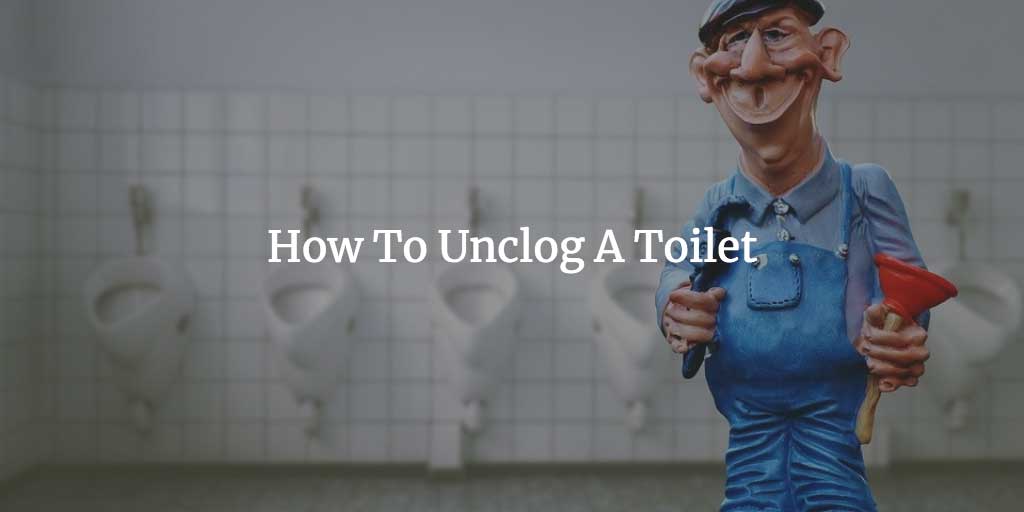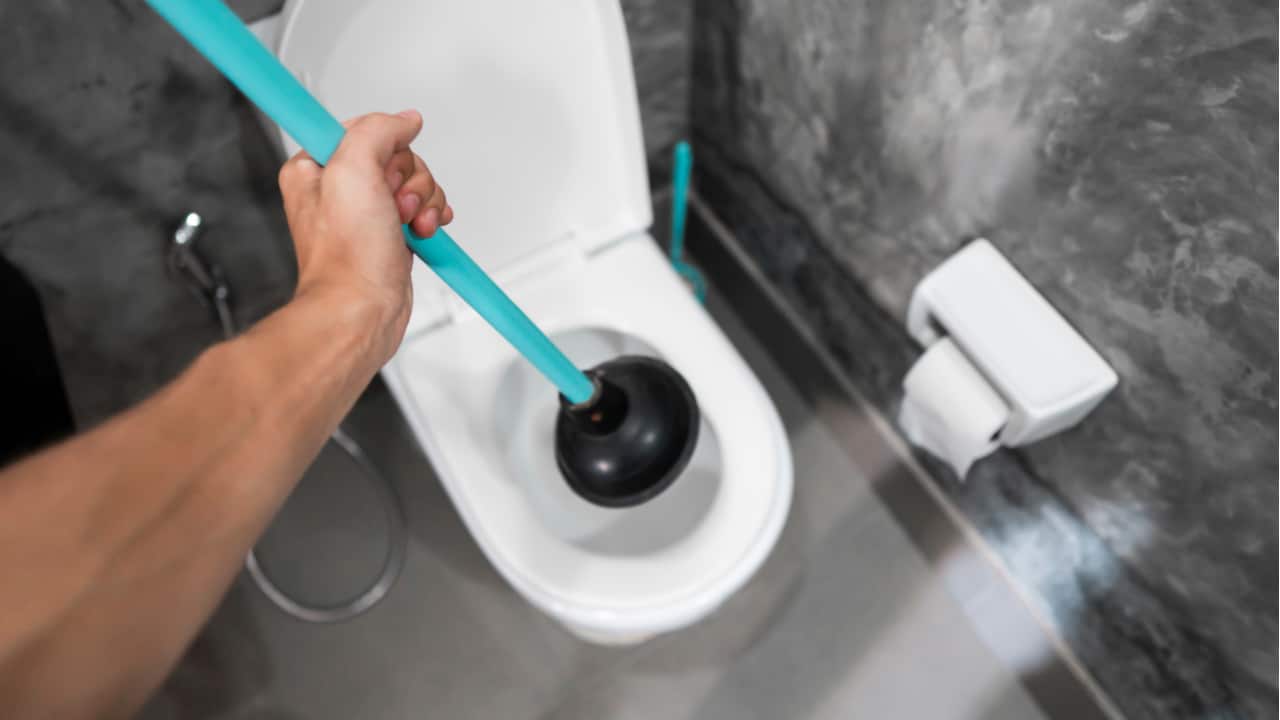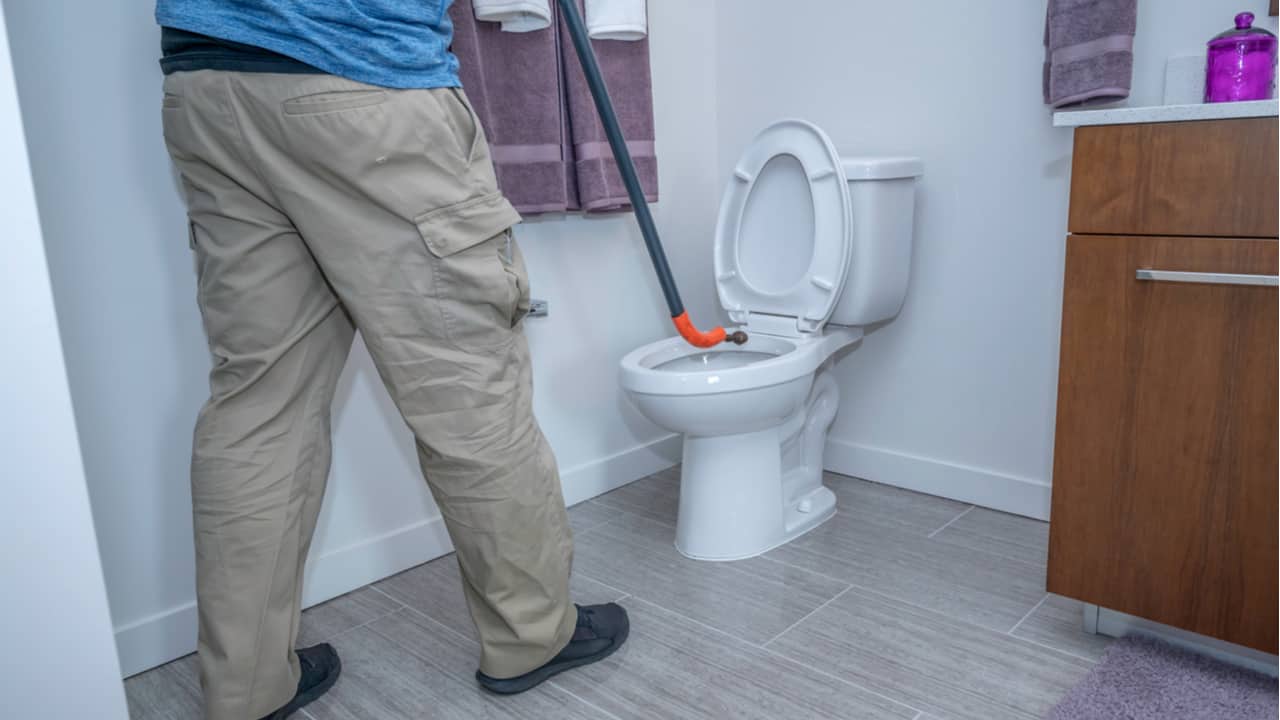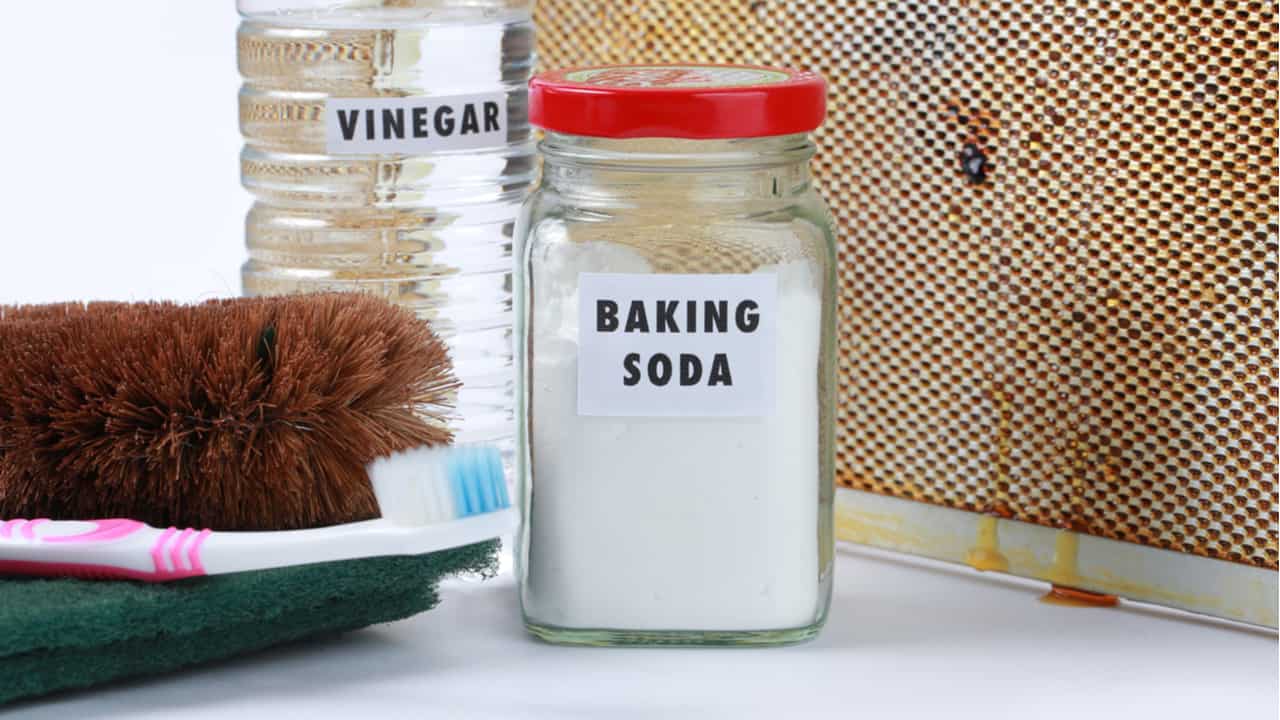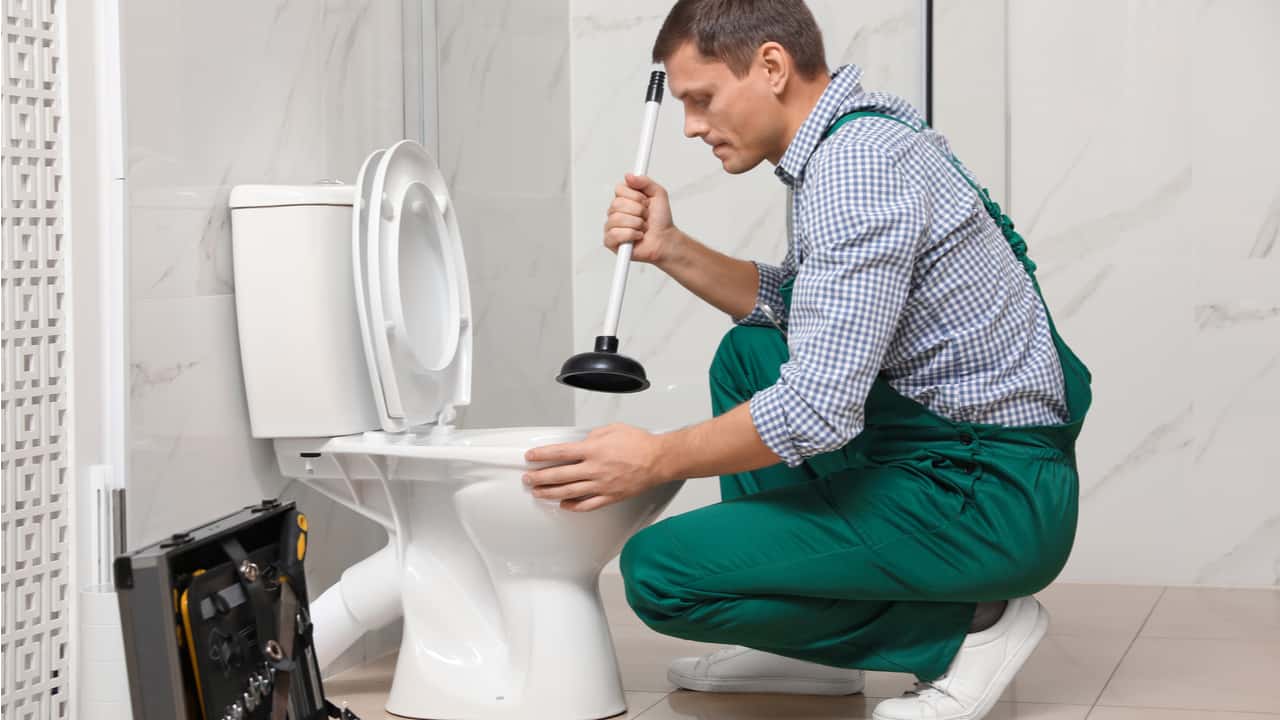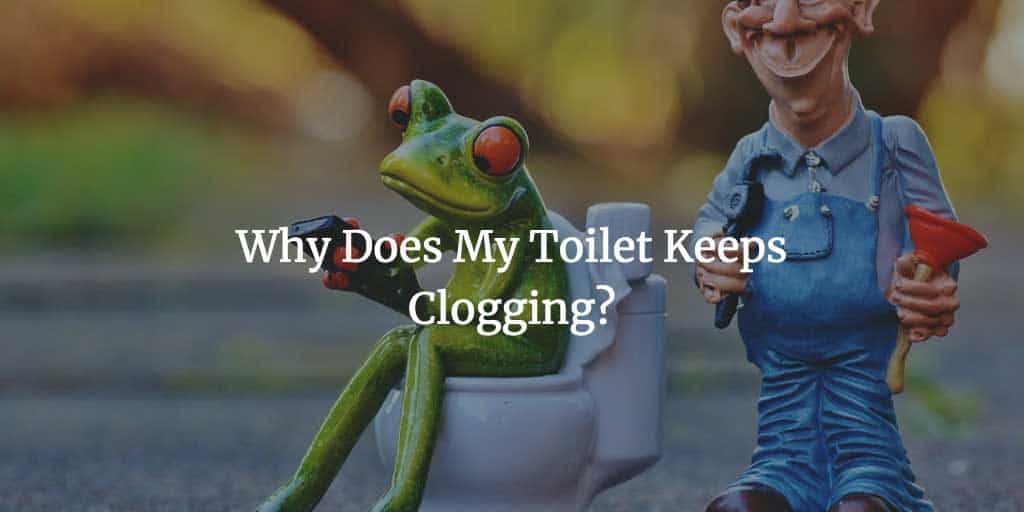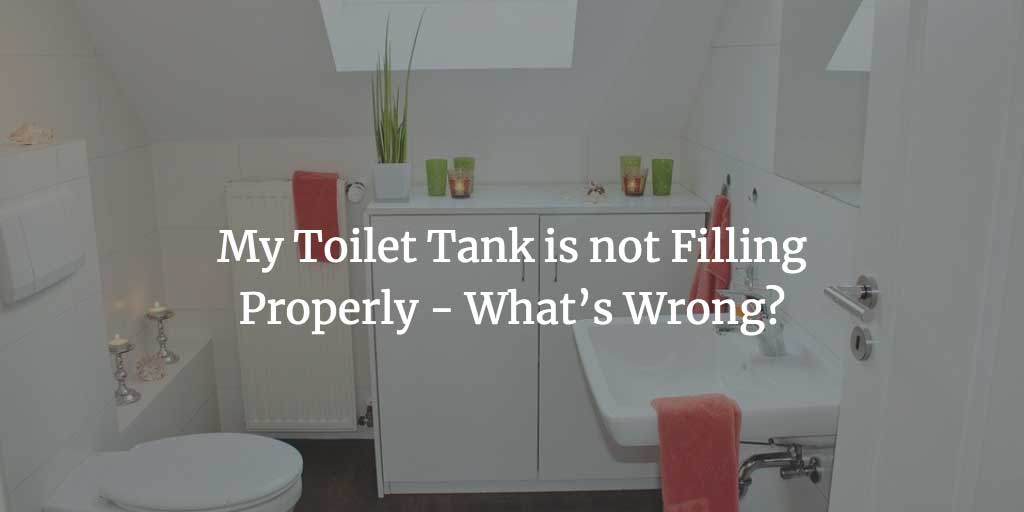A clogged toilet is usually no cause for alarm. But, is there anything more maddening than an overflowing toilet bowl? Luckily, it’s typically easy to unclog a toilet with and without a plunger. No matter how severe it seems, with a bit of elbow grease and DIY enthusiasm, you should be able to unclog it. Take a look at these steps to see which one is the best solution for how to unclog a toilet.
Contents
How Toilets Get Clogged
Every toiled comes with a built-in trap configuration, though it doesn’t seem like there’s much more to the plain porcelain figure. The toilet trap holds the standing water in order to stop nasty sewer gases from making their way into your bathroom. It works like the P-trap you can see beneath a bathroom sink.
The toilet trap obviously has its pitfalls–sometimes it may trap flushed objects–even normal toilet waste. Other times, people flush cat litter down the toilet or they flush dental floss and other stuff they really shouldn’t be. The only thing you should be flushing is human waste (and no, that doesn’t include hair)
When the toilet’s clogged, a plunger will solve the problem most of the time. But, it doesn’t always work. The most extreme solution would be removing the whole toilet.
But, before we start, you’d want to make sure you know what kind of toilet you are dealing with. Check out my Round vs Elongated Toilets comparison.
How to Unclog a Toilet With a Plunger
Plungers aren’t that straightforward as they seem. You need the right kind and you need to use it properly. Household plungers usually come in two forms–cup plungers and toilet plungers.
If your household plunger has a rubber cup with a flat rim, it’s not the one you need. A proper toilet plunger has a narrow bottom and a larger cup. It’s designed to fit into the hole in the toilet bowl. Due to its unique shape, it’s hard to mistake it for another type of plunger.
- Before you start plunging, the toilet bowl must be half full. Add water if needed. There must be some water in there so that the plunger can seal around the opening.
- Extend the narrow portion at the bottom of the plunger cup–also known as the flange. When it’s extended, you can use it to plunge clogged tubs and sinks. Place the plunger into the toilet at an angle.
- As you lower it, the cup should fill with water. It makes the job easier. Place the cup over the opening so that it seals around the outside of the opening and the flange stays inside the hole. Thrust the plunger down a couple of times swiftly and strongly. You need to use enough pressure so you would break up the obstruction.
- While you’re plunging, make sure to maintain a good seal. To help loosen the clog, the plunger will create a suction effect when it comes up. Six thrusts or so should do it.
- When you’re done thrusting, pull the plunger out to check if the water has cleared. The job is probably done if most of the water is gone.
- Take the lid off the toilet tank. To see if you’ve unclogged the toilet bowl, flush the water. Be careful–make sure you’re ready. If it seems like the toilet is about to start overflowing, push down the rubber flap. It is used to cover the hole in the tank. If you haven’t gotten the toilet unclogged, doing this quickly will prevent an overflow.
- You may need to plunge and flush a few more times until you’ve fully unclogged the bowl.
Unclogging a Toilet With an Auger
Again, you need the right type of tool for the job, so make sure your auger is designed for this purpose. A toilet auger is basically a long hollow guide tube. There’s a cable that runs through it and a sweep elbow at the bottom.
- It should also have a rubber sleeve that prevents it from scratching the porcelain. Your toilet auger must have a rubber sleeve as a plain metal auger can badly damage a toilet bowl.
- Make sure the tip of the cable is at the bottom of the tube by retracting the auger.
- Place the auger into the toilet bowl. The cable should reach into the opening and the sweep elbow should rest at the bottom of the toilet bowl.
- Crank the guide tube clockwise. As you’re cranking it, push the cable slowly into the trap. Stop it when you feel it can’t go further. To make sure the cable doesn’t double-back on itself and kink, crank it slowly again. You may need to coax the cable through the bends. In that case, reverse the cranking direction.
- Retract the cable out of the bowls. Even with the rubber sleeve, you may scratch the surface if you’re not careful enough, so be gentle.
- Check whether the clog has cleared by flushing the toilet.
Use a DIY Toilet Snake
A plumbing snake is somewhat similar to toilet augers. But, a drain snake is more likely to scratch the porcelain. Because of that, it shouldn’t be your first option. However, if you don’t have the right tools and are in a hurry to unclog the toilet, you can make your own drain snake out of a wire coat hanger.
To start, unravel it until it is straight. Place one end into the bowl and prod the waste. If it’s working, the toiled should start to unclog and the debris should flow down the waste.
Use Dish Soap to Unclog a Toilet Without a Plunger
If you don’t have the right tools for the job, there are plenty of other, simple solutions. As soon as the toilet bowl clogs, grab some dish soap from the kitchen and pour half a cup into the bowl.
The slipperiness of the dish soap should lubricate the toilet drain just enough to unclog it. It’s should help the debris slide down more easily. As an alternative, you can break up a bar of soap. To make things easier, you can place it in your microwave for a minute and a half and then chop it up in a blender.
Use Hot Water
If dish soap alone doesn’t do the job, add water to make things run smoother. But, avoid using boiling water as it could crack the bowl. Fill one bucket with hot water from a tap. Pour it into the bowl from waist level. The heat of the water paired with the force of pouring may be enough to unclog your toilet.
Use a Squirt Gun Toilet Drainer
Some methods can’t work if there’s water in the toilet bowl when you’re trying to repair it. This is a solid trick for plunger alternatives as it enables you to remove the water without much hassle. Don’t just flush and shut off the water supply because it won’t always be enough. Simply use a squirt gun to remove the water.
Use a Plastic Bottle
Be extra careful with this one as it could get pretty messy. Use a small container or a squirt gun to remove as much water from the bowl as you can. Grab a big plastic bottle and fill it with warm water. You’d want to put on a pair of rubber gloves before you continue.
Use your thumb to prevent the warm water from leaking too early. put the top of the bottle into the opening of the drain inside the bowl. Then, squeeze the bottle. The force of the water may be enough to dislodge the debris.
Use Vinegar and Baking Soda
This step is pretty straightforward as it just requires a cup of baking soda and two cups of vinegar. White or apple cider vinegar will do. The bowl needs to be halfway full for this to work.
If there’s not enough water, pour a bit of hot water into the bowl so that the level will be high enough. Don’t overdo it as it may lead to spillage. Once you’ve adjusted the water level, pour the baking soda into the toilet.
Then pour the vinegar into the clogged toilet, but make sure to do it slowly. Even though it’s simple household chemistry, the reaction could be quite messy if you pour too quickly. If it seems like too much fizz is about to happen, don’t pour the whole cup. Wait for half an hour.
The water should go down if the toilet clog breaks up. Take the lid off the toilet tank and be ready to use to cover for the tank hole to shut off the water. If you see bubbles, you may flush the toilet. If it doesn’t flush properly, shut the water. You may need to repeat the process a few times.
This mixture is also great for getting rid of toilet rings.
Use Chemicals
If mechanics and household chemistry don’t do the trick, you can always use chemicals. It’s best to use a non-corrosive product like Wild Tornado as such a cleaner won’t damage your toilet drain. Still, you should wear a face mask and rubber gloves. You’ll also need to remove the water from the toilet for this to work. Simply follow the instructions on your cleaner.
You might want to check out my guide on how to fix a toilet that keeps clogging up as well.
Preventing Toilet Clogs
- Don’t flush products that are not intended for toilet use down the bowl.
- Don’t use too much toilet paper. To prevent a toilet clog, you can always flush in increments.
- If you have children, make sure to explain to them that they can only flush toilet paper.
When To Call a Plumber
If an auger and plunger don’t do the job, chances are the other DIY steps won’t help either. They are simply an alternative. Your next best bet is a professional plumber. A clogged toilet that’s difficult to fix could be a sign of a much bigger problem.
Summary
If you’re facing a clogged toilet, there’s no need to panic. Chances are, some of these steps can help you solve the problem quickly and easily. Pick one that’s most convenient for you. If you’re having a hard time unclogging your toilet without and with a plunger, drop the tools and chemicals and call a plumber. Unless there’s a bigger problem under the surface, they should be able to fix it in a jiffy.
